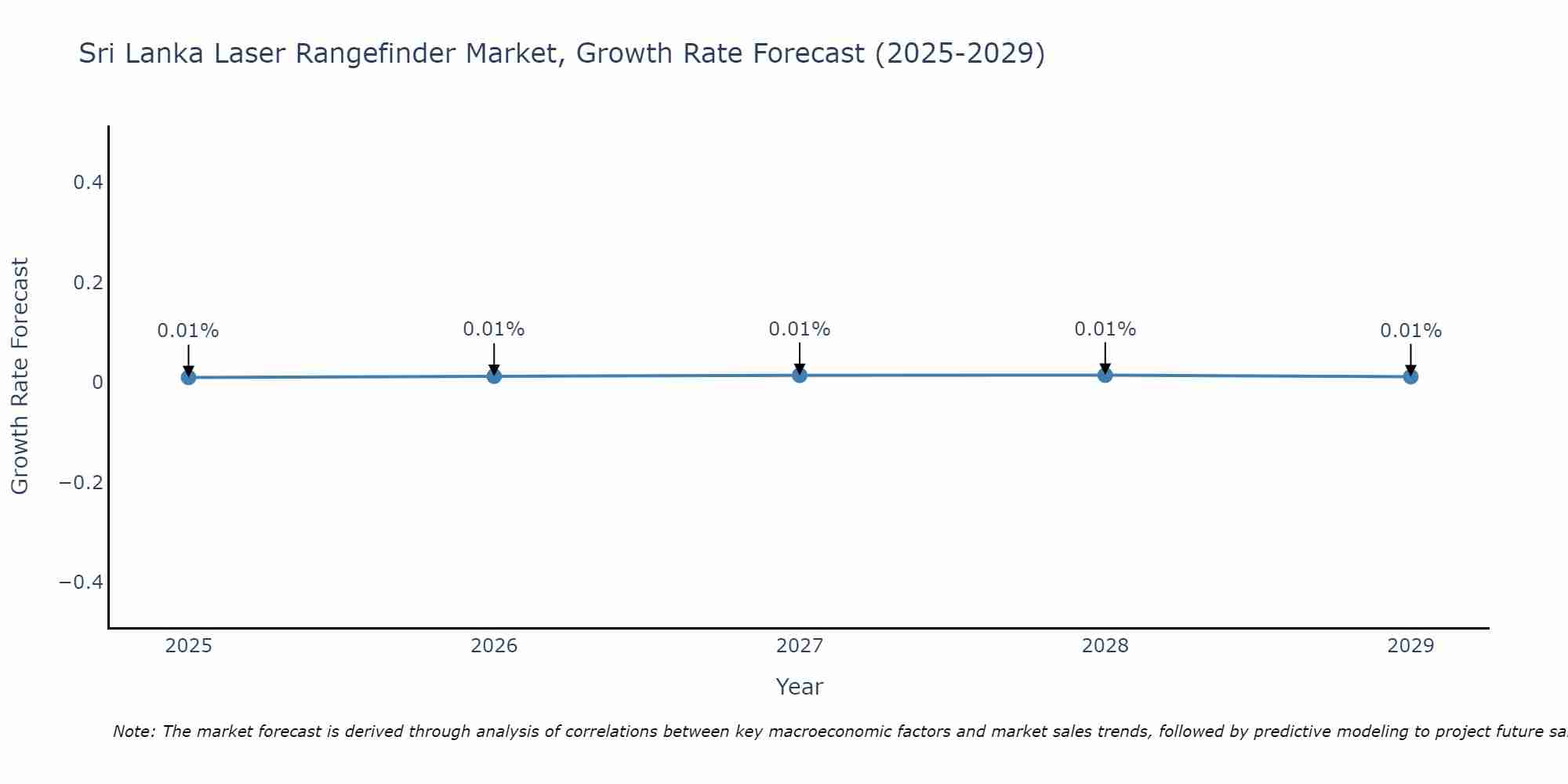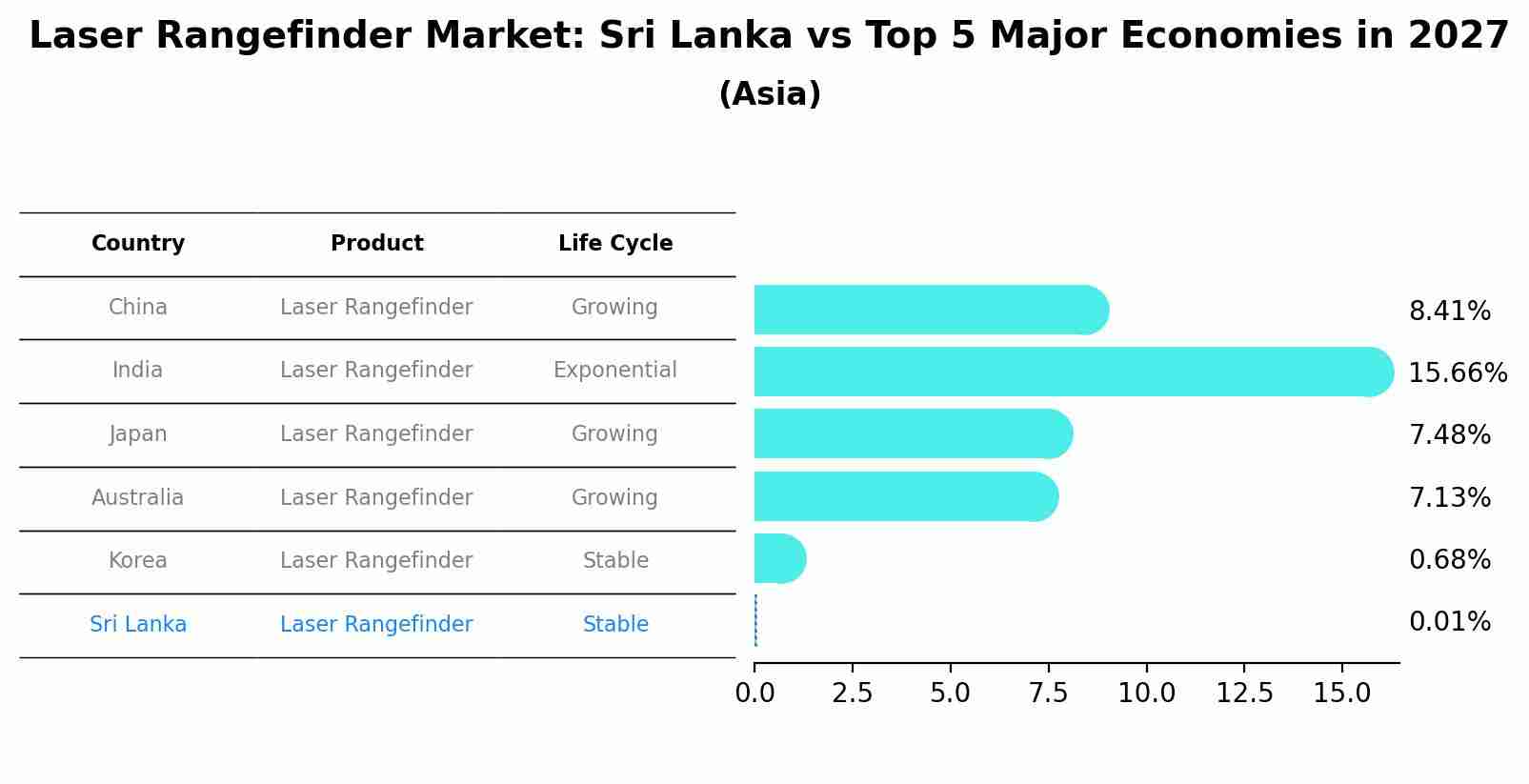Sri Lanka Laser Rangefinder Market Outlook | Revenue, Companies, COVID-19 IMPACT, Share, Size, Analysis, Industry, Forecast, Trends, Value & Growth
| Product Code: ETC365971 | Publication Date: Aug 2022 | Updated Date: Aug 2025 | Product Type: Market Research Report | |
| Publisher: 6Wresearch | No. of Pages: 75 | No. of Figures: 35 | No. of Tables: 20 | |
Sri Lanka Laser Rangefinder Market Size Growth Rate
The Sri Lanka Laser Rangefinder Market is projected to witness mixed growth rate patterns during 2025 to 2029. The growth rate begins at 0.01% in 2025, climbs to a high of 0.01% in 2028, and moderates to 0.01% by 2029.

Laser Rangefinder Market: Sri Lanka vs Top 5 Major Economies in 2027 (Asia)
Sri Lanka's Laser Rangefinder market is anticipated to experience a stable growth rate of 0.01% by 2027, reflecting trends observed in the largest economy China, followed by India, Japan, Australia and South Korea.

Sri Lanka Laser Rangefinder Market Overview
The Sri Lankan laser rangefinder market caters primarily to defense and outdoor recreational activities, offering precise distance measurement capabilities based on laser technology. Laser rangefinders find applications in military operations, hunting, and surveying, providing users with accurate distance readings over long ranges. Sri Lanka market is shaped by defense procurement policies and increasing interest in outdoor sports, driving demand for rugged and reliable rangefinder solutions. Both international manufacturers and local distributors contribute to market competitiveness and product availability.
Drivers of the market
The market for laser rangefinders in Sri Lanka is influenced by increasing applications in military & defense, forestry, and sports & recreational activities. Laser rangefinders provide accurate distance measurements over long ranges, essential for target acquisition, surveying, and outdoor sports. Advancements in laser ranging technology, including enhanced accuracy and integration with digital mapping systems, drive market expansion. Additionally, the growing popularity of precision shooting sports and wildlife conservation efforts further boost demand for laser rangefinders.
Challenges of the market
In the Laser Rangefinder market, challenges include the demand for higher accuracy and longer range capabilities while maintaining affordability. Additionally, there is a need to keep up with advancements in technology to provide features like better resolution, faster response times, and improved durability.
Government Policy of the market
Policies encourage the use of laser rangefinders in defense, surveying, and industrial applications. This includes regulations on the import and use of laser technology, support for local manufacturing capabilities, and partnerships with defense agencies to enhance national security through advanced rangefinding technologies.
Key Highlights of the Report:
- Sri Lanka Laser Rangefinder Market Outlook
- Market Size of Sri Lanka Laser Rangefinder Market, 2021
- Forecast of Sri Lanka Laser Rangefinder Market, 2028
- Historical Data and Forecast of Sri Lanka Laser Rangefinder Revenues & Volume for the Period 2018 - 2028
- Sri Lanka Laser Rangefinder Market Trend Evolution
- Sri Lanka Laser Rangefinder Market Drivers and Challenges
- Sri Lanka Laser Rangefinder Price Trends
- Sri Lanka Laser Rangefinder Porter's Five Forces
- Sri Lanka Laser Rangefinder Industry Life Cycle
- Historical Data and Forecast of Sri Lanka Laser Rangefinder Market Revenues & Volume By Type for the Period 2018 - 2028
- Historical Data and Forecast of Sri Lanka Laser Rangefinder Market Revenues & Volume By Telescope Later Rangefinder for the Period 2018 - 2028
- Historical Data and Forecast of Sri Lanka Laser Rangefinder Market Revenues & Volume By Hand-held Later Rangefinder for the Period 2018 - 2028
- Historical Data and Forecast of Sri Lanka Laser Rangefinder Market Revenues & Volume By Application for the Period 2018 - 2028
- Historical Data and Forecast of Sri Lanka Laser Rangefinder Market Revenues & Volume By Military for the Period 2018 - 2028
- Historical Data and Forecast of Sri Lanka Laser Rangefinder Market Revenues & Volume By Construction for the Period 2018 - 2028
- Historical Data and Forecast of Sri Lanka Laser Rangefinder Market Revenues & Volume By Industrial for the Period 2018 - 2028
- Historical Data and Forecast of Sri Lanka Laser Rangefinder Market Revenues & Volume By Sports for the Period 2018 - 2028
- Historical Data and Forecast of Sri Lanka Laser Rangefinder Market Revenues & Volume By Forestry for the Period 2018 - 2028
- Historical Data and Forecast of Sri Lanka Laser Rangefinder Market Revenues & Volume By Others for the Period 2018 - 2028
- Sri Lanka Laser Rangefinder Import Export Trade Statistics
- Market Opportunity Assessment By Type
- Market Opportunity Assessment By Application
- Sri Lanka Laser Rangefinder Top Companies Market Share
- Sri Lanka Laser Rangefinder Competitive Benchmarking By Technical and Operational Parameters
- Sri Lanka Laser Rangefinder Company Profiles
- Sri Lanka Laser Rangefinder Key Strategic Recommendations
Frequently Asked Questions About the Market Study (FAQs):
- Single User License$ 1,995
- Department License$ 2,400
- Site License$ 3,120
- Global License$ 3,795
Search
Related Reports
- ASEAN Bearings Market (2025-2031) | Strategy, Consumer Insights, Analysis, Investment Trends, Opportunities, Growth, Size, Share, Industry, Revenue, Segments, Value, Segmentation, Supply, Forecast, Restraints, Outlook, Competition, Drivers, Trends, Demand, Pricing Analysis, Competitive, Strategic Insights, Companies, Challenges
- Europe Flooring Market (2025-2031) | Outlook, Share, Industry, Trends, Forecast, Companies, Revenue, Size, Analysis, Growth & Value
- Saudi Arabia Manlift Market (2025-2031) | Outlook, Size, Growth, Trends, Companies, Industry, Revenue, Value, Share, Forecast & Analysis
- Uganda Excavator, Crane, and Wheel Loaders Market (2025-2031) | Strategy, Consumer Insights, Analysis, Investment Trends, Opportunities, Growth, Size, Share, Industry, Revenue, Segments, Value, Segmentation, Supply, Forecast, Restraints, Outlook, Competition, Drivers, Trends, Demand, Pricing Analysis, Competitive, Strategic Insights, Companies, Challenges
- Rwanda Excavator, Crane, and Wheel Loaders Market (2025-2031) | Strategy, Consumer Insights, Analysis, Investment Trends, Opportunities, Growth, Size, Share, Industry, Revenue, Segments, Value, Segmentation, Supply, Forecast, Restraints, Outlook, Competition, Drivers, Trends, Demand, Pricing Analysis, Competitive, Strategic Insights, Companies, Challenges
- Kenya Excavator, Crane, and Wheel Loaders Market (2025-2031) | Strategy, Consumer Insights, Analysis, Investment Trends, Opportunities, Growth, Size, Share, Industry, Revenue, Segments, Value, Segmentation, Supply, Forecast, Restraints, Outlook, Competition, Drivers, Trends, Demand, Pricing Analysis, Competitive, Strategic Insights, Companies, Challenges
- Angola Excavator, Crane, and Wheel Loaders Market (2025-2031) | Strategy, Consumer Insights, Analysis, Investment Trends, Opportunities, Growth, Size, Share, Industry, Revenue, Segments, Value, Segmentation, Supply, Forecast, Restraints, Outlook, Competition, Drivers, Trends, Demand, Pricing Analysis, Competitive, Strategic Insights, Companies, Challenges
- Israel Intelligent Transport System Market (2025-2031) | Strategy, Consumer Insights, Analysis, Investment Trends, Opportunities, Growth, Size, Share, Industry, Revenue, Segments, Value, Segmentation, Supply, Forecast, Restraints, Outlook, Competition, Drivers, Trends, Demand, Pricing Analysis, Competitive, Strategic Insights, Companies, Challenges
- Uganda Precast and Aggregate Market (2025-2031) | Strategy, Consumer Insights, Analysis, Investment Trends, Opportunities, Growth, Size, Share, Industry, Revenue, Segments, Value, Segmentation, Supply, Forecast, Restraints, Outlook, Competition, Drivers, Trends, Demand, Pricing Analysis, Competitive, Strategic Insights, Companies, Challenges
- Australia IT Asset Disposal Market (2025-2031) | Strategy, Consumer Insights, Analysis, Investment Trends, Opportunities, Growth, Size, Share, Industry, Revenue, Segments, Value, Segmentation, Supply, Forecast, Restraints, Outlook, Competition, Drivers, Trends, Demand, Pricing Analysis, Competitive, Strategic Insights, Companies, Challenges
Industry Events and Analyst Meet
Our Clients
Whitepaper
- Middle East & Africa Commercial Security Market Click here to view more.
- Middle East & Africa Fire Safety Systems & Equipment Market Click here to view more.
- GCC Drone Market Click here to view more.
- Middle East Lighting Fixture Market Click here to view more.
- GCC Physical & Perimeter Security Market Click here to view more.
6WResearch In News
- Doha a strategic location for EV manufacturing hub: IPA Qatar
- Demand for luxury TVs surging in the GCC, says Samsung
- Empowering Growth: The Thriving Journey of Bangladesh’s Cable Industry
- Demand for luxury TVs surging in the GCC, says Samsung
- Video call with a traditional healer? Once unthinkable, it’s now common in South Africa
- Intelligent Buildings To Smooth GCC’s Path To Net Zero













